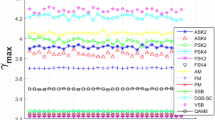Abstract
The automatic modulation recognition of communication signal has been widely used in many fields. However, it is very difficult to recognize the modulation in low SNR. Based on information entropy features and Dempster-Shafer evidence theory, a novel automatic modulation recognition methods is proposed in this paper. Firstly, Rényi entropy and singular entropy is used to obtain the modulation feature. Secondly, based on the normal test theory, a novel basic probability assignment function(BPAF) is presented. Finally, Dempster-Shafer evidence theory is used as a classifier. Experiment results indicate that the new approach can obtain a higher recognition result in low SNR.







Similar content being viewed by others
References
Nandi AK, Azzouz EE (1998) Algorithms for automatic modulation recognition of communication signals[J]. IEEE Trans Commun 46(4):431–436
Guo J-j, Hong-dong Y, Lu J, Heng-fang M (2014) Recognition of Digital Modulation Signals via Higher Order Cumulants[J]. Communications Technology 11:1255–1260
Zhu L, Cheng H-W, Wu L-n (2009) Identification of Digital Modulation Signals Based on Cyclic Spectral Density and Statistical Parameters[J]. J Appl Sci 2:137–143
Liu S, Fu W, He L et al (2017) Distribution of primary additional errors in fractal encoding method [J]. Multimedia Tools and Applications 76(4):5787–5802
Liu S, Pan Z, Fu W, Cheng X (2017) Fractal generation method based on asymptote family of generalized Mandelbrot set and its application [J]. Journal of Nonlinear Sciences and Applications 10(3):1148–1161
Li J (2015) A New Robust Signal Recognition Approach Based on Holder Cloud Features under Varying SNR Environment[J]. KSII Transactions on Internet and Information Systems 9(12):4934–4949 12.31
Liu S, Pan Z, Cheng X (2017) A Novel Fast Fractal Image Compression Method based on Distance Clustering in High Dimensional Sphere Surface [J]. Fractals, 25(4), 1740004: 1–11
Liu S, Lu M, Liu G et al (2017) A Novel Distance Metric: Generalized Relative Entropy [J]. Entropy 19(6):269. https://doi.org/10.3390/e19060269
Pawar SU, Doherty JF (2011) Modulation Recognition in Continuous Phase Modulation Using Approximate Entropy[J]. IEEE Transactions on Information Forensics & Security 6(3):843–852
Li J, Guo J (2015) A New Feature Extraction Algorithm Based on Entropy Cloud Characteristics of Communication Signals[J]. Math Probl Eng 2015:1–8
He Z-y, Yu-mei C, Qing-quan Q (2005) A Study of Wavelet Entropy Theory and its Application in Electric Power System Fault Detection[J]. Proceedings of the CSEE 5:40–45
Bo J, Dong X-z, Shen-xing S (2015) Application of approximate entropy to cross-country fault detection in distribution networks[J]. Power System Protection and Control 7:15–21
Lin-yi Z, Zhi-cheng L, He J-z (2009) Application of Hierarchy-Entropy Combination Assigning Method in Radar Emitter Recognition[J]. Command Control & Simulation 6:27–29
Jing-chao Li, Yu-long Ying (2014) Radar Signal Recognition Algorithm Based on Entropy Theory[C]. 2014 2nd International Conference on Systems and Informatics, 718–723. https://doi.org/10.1109/ICSAI.2014.7009379
Sucic V, Saulig N, Boashash B (2014) Analysis of local time-frequency entropy features for nonstationary signal components time supports detection[J]. Digital Signal Processing 34(1):56–66
Hang B, Yong-jun Z, Shen W, Xu Y-g (2013) Radar emitter recognition based on rényi entropy of time-frequency distribution[J]. Journal of Circuits and System 1:437–442
Rui Z, Si Z, He Z, et al (2015) A joint detection based on the DS evidence theory for multi-user superposition modulation[C]. IEEE International Conference on Network Infrastructure and Digital Content. IEEE, 390–393. https://doi.org/10.1109/ICNIDC.2014.7000331
Xin Y, Zhu Q (2013) Cooperative Modulation Recognition Method based on Multi-Type Feature Parameters and Improved DS Evidence Theory[J]. J Converg Inf Technol 8(11):258–266
Lei L, Wang X-d, Ya-qiong X, Kai B (2013) Multi-polarized HRRP classification by SVM and DS evidence theory[J]. Control and Decision 6:861–866
Lin Y, Wang C, Ma C et al (2016) A new combination method for multisensor conflict information[J]. J Supercomput 72(7):2874–2890
Luo X, Luo H, Jin-deng Z, Lei L (2012) Error-correcting Output Codes Based on Classifier’ Confidence for Multi-class Classification[J]. Science Technology and Engineering 22:5502–5508
Wen-sheng DENG, Xiao-mei SHAO, Hai LIU (2017) Discussion of Remote Sensing Image Classification Method Based on Evidence Theory[J]. Journal of Remote Sensing 4:568–573
Peng-fei NIU, Sheng-da WANG, Jian MA (2007) Radar target recognition based on Subordinate Function and D-S Theory[J]. Microcomputer Information 31:218–220
Jie X (2006) Fuzzy recognition of airborne radar based on D-S evidence theory[J]. Command Control & Simulation 4:33–36
D’Agostino R (1970) Transformation to normality of the null distribution of g1. Biometrika 57(3):679–681
Jarque C, Bera A (1980) Efficient tests for, normality, homoscedasticity and serial independence of regression residuals. Econ Lett 6(3):255–259
Lilliefors H (1967) On the Kolmogorov-Smirnov test for normality with mean and variance unknown. J Am Stat Assoc 62:399–402
Deng X-m, Ying-sheng Z (1964) The introduction of a simple method for the normal test[J]. Chinese School Health 3:167–169
Xu Pei-da; Deng Yong, Su, Xiao-yan. A new method to determine basic probability assignment from training data[J]. Knowl-Based Syst, 2013, 46(1): 69-80
Acknowledgments
This work is supported by the National Natural Science Foundation of China (61771154,61301095), the Key Development Program of Basic Research of China (JCKY2013604B001), the Fundamental Research Funds for the Central Universities (GK2080260148 and HEUCF1508).
We gratefully thank of very useful discussions of reviewers.
Author information
Authors and Affiliations
Corresponding author
Ethics declarations
Conflict of Interest
Meantime, all the authors declare that there is no conflict of interests regarding the publication of this article.
Rights and permissions
About this article
Cite this article
Wang, H., Guo, L., Dou, Z. et al. A New Method of Cognitive Signal Recognition Based on Hybrid Information Entropy and D-S Evidence Theory. Mobile Netw Appl 23, 677–685 (2018). https://doi.org/10.1007/s11036-018-1000-8
Published:
Issue Date:
DOI: https://doi.org/10.1007/s11036-018-1000-8




